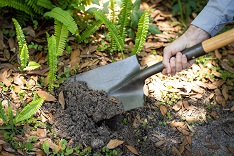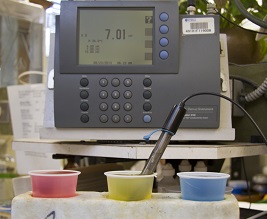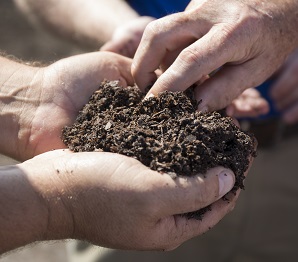Soil is the foundation of the landscape. Having a soil pH test done may be the best place to start when planting a new garden, new landscape, or when your landscape is showing signs of stress. If you live near the ocean and irrigate with a well, you may also need to test your irrigation water for salt intrusion. But let’s save that for another article.

Start With The Sample – Collecting your soil sample for in-house pH tests
The following are instructions for collecting a residential soil sample and submitting it for Extension Indian River County soil pH testing. You may submit more than one sample
- Scrape away the top inch of the soil surface from a small area which you would like to have tested. This will expose the root zone, where plant roots take up nutrients.
- Scoop about ½ cup of this root-zone soil and place it in a baggie or a clean jar with a lid. Label this if you are submitting more than one sample. Example: Front bed, west side fence, etc.
- If your soil is still moist, leave the collection container open indoors overnight so that moisture can evaporate. Excess soil moisture may negatively affect your soil pH test.
- Take your sample(s) to your local County Extension Office and be sure to include your name, phone number, email address, and name of plant you are trying to grow.
Most local County Extension offices offer pH testing of your residential soil. While some counties will charge a small fee for in-house soil pH testing, Indian River County Extension still offers free soil pH testing for Indian River County Residents.
Once the testing is completed, a local Florida Master Gardener will contact you by phone or email with the results. That is the time to ask any questions you may have regarding your test or why your plants are not thriving in that area. Additionally, the Master Gardener may ask you more questions in order to help diagnose any problems.

Types of Soil Tests Offered Through Extension:
- pH testing in our office- free of charge
- UF Soils Lab Testing- you collect samples, and mail them to UF Soils Lab with your check for the cost of testing
- New Soil Test Kit just for turf grass- one time online fee for each test- results tell you how to treat your lawn, with what product, and how much
- Producer/Pasture soil testing- you collect samples from your farm or pasture and mail them to UF Soils Lab with your check for the cost of testing
Florida residents have the option of submitting soil samples to the University of Florida’s Soils Laboratory. All UF Soils Lab tests include pH testing. However, the UF Soils Lab tests for soil fertility and content of nutrients such as phosphorous (P), potassium (K), calcium (Ca) and magnesium (Mg). There is no test for Nitrogen as this element volatizes (evaporates) into the atmosphere rapidly. The UF Soils Lab will email your results to you as well as to your local Extension Agriculture agent. There may be liming recommendations if necessary. There is a fee for each UF Soils Lab test you submit but the information is invaluable in terms of the results. For avid gardeners, it recommended that you conduct a full soil test every 2 years.
Right Plant, Right Place
Following Florida Friendly Landscaping practices makes good sense. If we plant what grows well in our native soil conditions, the right plant, these plants do not need much added help in the way of chemical fertilizers, pesticides, and fungicides. It could be good for your wallet as well as good for the environment to plant the right plants for your soil pH. If a plant will thrive in our native soil without chemical inputs there would be less runoff to pollute our waterways.
However, sometimes you just have to grow that one plant that reminds you of your childhood. Unfortunately, that French Lavender just does not thrive in Florida. This is when you may need to grow in a container where you can control the soil conditions for that one special specimen. And know that it’s life-expectancy will be short-lived.
So, What is pH?
The term “pH” stands for, “potential of hydrogen”. As the amount of hydrogen ions in the soil increases, the soil pH decreases thus becoming more acidic. Testing for pH is simply testing the acidity of the soil. The numbers range from zero (extremely acid) to 14 (extremely alkaline), with 7 being neutral acidity. So, the lower the number the more acidic your soil. Most plants do well in a soil which is 6.2 to 6.8, or near neutral.
If your soil is too acid for the types of plants you are growing, the pH may be neutralized by “liming”. Liming is adding garden lime to the soil. This should only be done if you have had a pH test to determine it is necessary.
Likewise, adding mulch and compost to your landscape may decrease your pH, making it a bit more acid for a short period of time. Yes, compost is most always a mild acidifier when added to the soil. And there are a few plants which prefer soil on the acid side of the pH scale (see the list below).

Plants which like acidic soils:
- Gardenia 5.5 – 6.5
- Ixora 5 – 6.5
- Azalea 5 – 6.0
- Blueberries 5 – 5.5
Green Thumb or Black Thumb?
“I have a black thumb. Everything I plant always dies”. If you have thought this, you may just be planting the wrong plants for your growing conditions. If those plants were annuals, they are expected to die when their life cycle is over. Know your plants before you plant them. Big-box garden centers will entice you with a wide colorful variety of beautifully blooming annuals. But are those snapdragons happy growing in Florida? Can you successfully grow that beautifully flowering Fuchsia in humid Florida conditions? Do a little research. Look around to see what pretty plants your neighbors are having success with and learn what grows well in our soils. We humans learn more from our mistakes than from our triumphs. With some knowledge, you may discover you do have a green thumb.
Read more about how soil pH affects plant growth in this University of Florida Institute of Food and Agricultural Sciences Electronic Data Information Source (UF/IFAS EDIS) publication: “Soil pH in the Home Landscape or Garden“.
Composting publications from UF/IFAS EDIS: “Compost Tips for the Home Gardener”
“Recycling Organic Materials To Improve your Florida-Friendly Edible Landscape”
“Herbicide Residue in Manure, Compost, or Hay”
Soil Sampling topics from EDIS: “Soil Sampling and Testing for the Home Landscape or vegetable Garden”
“Soil Testing For Plant-Available Nutrients- What is it and why do we use it?”
The UF/IFAS Soils Laboratory Website to download your submission form as a pdf file
 2
2
